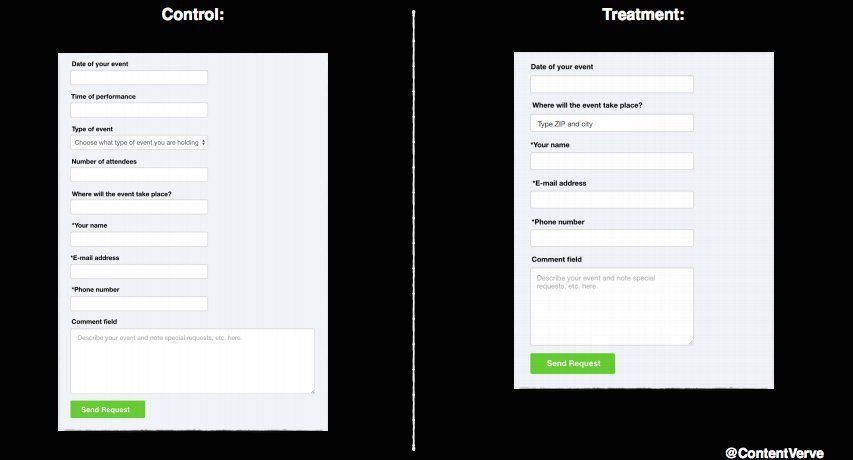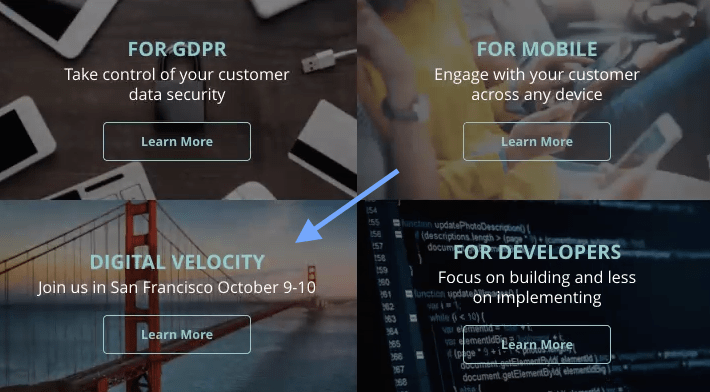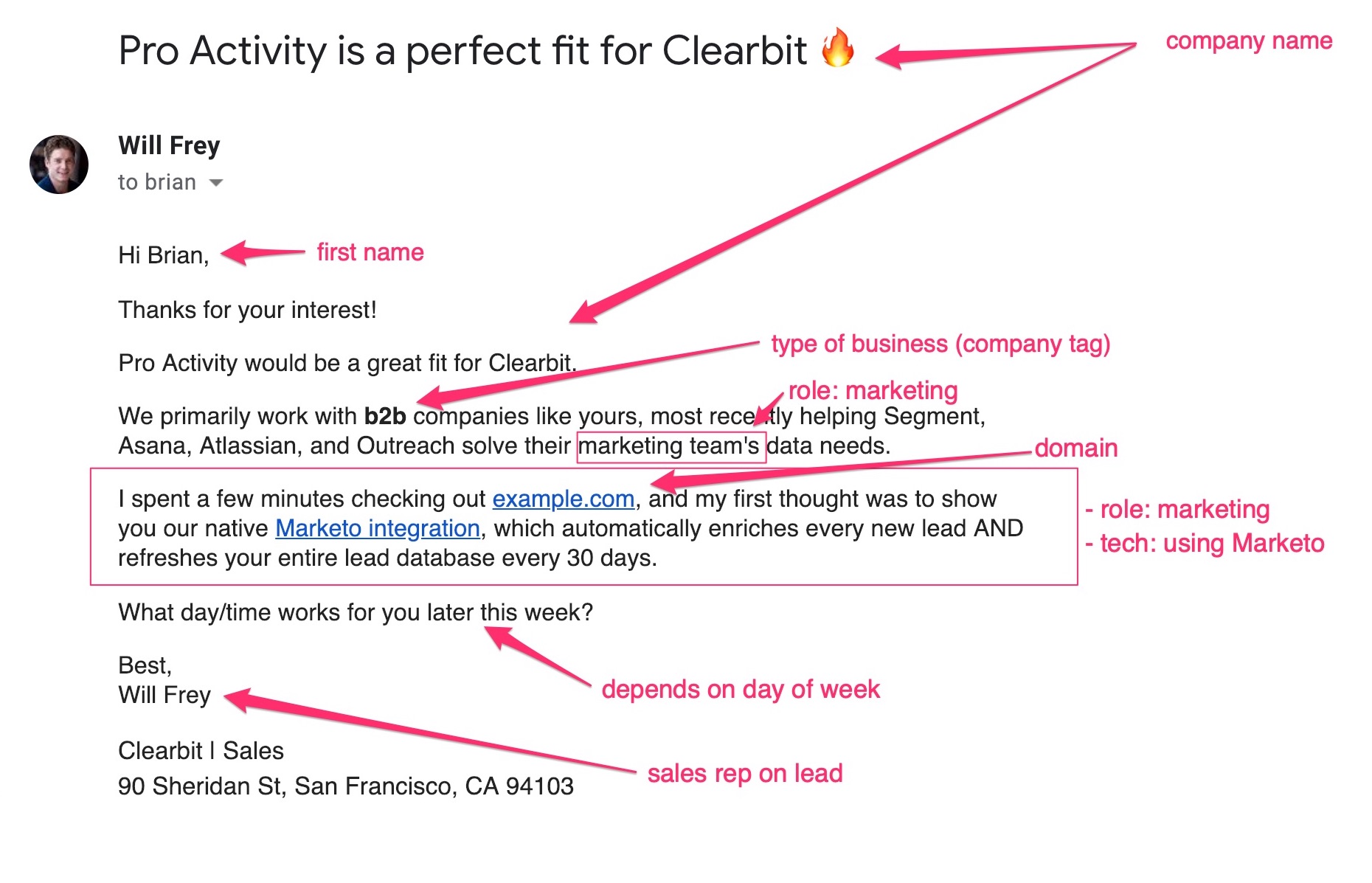5 ways Clearbit improves conversion quality through the funnel
Ask any marketer or salesperson what they’re thinking about at the end of the quarter, and chances are they’ll mumble (or grumble), “converting more leads.”
But if you ask the same question at the beginning of the quarter, when they’re feeling refreshed and motivated, they’ll probably have a more sensible answer for you: “converting leads more efficiently.”
Converting efficiently means converting more people from your ICP (Ideal Customer Profile), who tend to become successful, long-term users. This targeted approach may not give you the same volume play as a broader acquisition strategy, but it’s far more scalable in the long-run: your sales and marketing teams can focus precious resources on nurturing high-LTV accounts instead of wading through lots of low-quality leads.
With Clearbit, you can enrich databases and unmask anonymous web traffic to gain access to hundreds of data points about your site visitors and leads — all piped into your existing B2B marketing and sales tech stack (think Salesforce, Hubspot, Marketo, Drift, Google Analytics, Facebook Ads). From there, the possibilities abound for optimizing your buyer journey for quality, efficient conversion.
To start, check out five favorite tactics we’ve come across both here at Clearbit and from our customers.
Jump ahead to:
- Think of lead forms as a conversation
- Don’t just personalize your website, personalize the buyer journey
- Pair Facebook’s reach with LinkedIn’s targeting power
- Write automated emails that rival those of your top SDRs and CSRs
- Give your live chat an EQ boost
1. Think of lead forms as a conversation
Even the most beautiful landing page on the interwebs won’t get you far if your content is gated behind a long, tedious lead form.
This may sound obvious, but the vast majority of marketers still violate this basic UX principle. Most companies can’t help but sneak in an extra form field (or 10) on behalf of their sales team. In fact, in 2015, the average number of form fields was 11. 11!
And it’s not just about making shorter lead forms, either. Studies have shown that visitors actually like filling out form fields they find relevant and important to share. For example, check out the form below, where visitors can book entertainers for their events.
Conversion optimization expert Michael Aagaard discovered that streamlining this form from 6 to 9 fields actually reduced its performance by 14%. They had cut engaging questions about the party itself, like "type of event" and "time of performance," and left more mundane fields like "email address" and "phone number."
 Left: the original 9-field form; Right: the streamlined 6-field form led to a 14% drop in conversion
Left: the original 9-field form; Right: the streamlined 6-field form led to a 14% drop in conversionIt turns out visitors wanted to answer specific, relevant questions– the kind you might ask when striking up a conversation in real life.
The highest-converting lead forms are short, engaging, and don't disrespect your visitor’s time by asking for information that’s publicly available. And that's where data enrichment comes in. With Clearbit Form Shortening, you can create dynamic forms that keep fields at a minimum by collecting dozens of relevant data points and piping them into your CRM and marketing automation platform.
Dynamic lead forms allow your website visitor to skip the manual data entry and get to your world’s most beautiful landing page faster; on the flip side, they also help your sales and marketing teams to capture valuable information to do their jobs.
2. Don’t just personalize your website, personalize the buyer journey
In the early days, you probably maintained one website to sell your product to as many people as you possibly could. Likely, that meant using fairly generic product messaging that aimed to please everyone.
That works...until it doesn’t. If your product hits traction, you’ll inevitably reach a point when your catchall website no longer serves your Total Addressable Market (TAM). Perhaps you’re targeting enterprise customers, in addition to startups. Perhaps you’ve added new personas, or begun outbound sales in addition to self-serve. How do you create one website that hooks all of these audiences in less than eight seconds?
In short, you don’t. With data from a reverse-IP tool like Clearbit Reveal, you can serve your website visitor a customized landing page and buyer journey based on attributes like industry, account, location, etc.
For instance Tealium, a tag management system, uses Clearbit Reveal to de-anonymize website visitors and serve them dynamic, customized landing pages with relevant content. When someone from an e-commerce site lands on their homepage, they’ll see copy that speaks to the retail industry:
And if that visitor is based in the Bay Area, they’ll see a highlighted event that Tealium is organizing in their city:

Personalizing your marketing site is just the tip of the iceberg. You can take this one step further and personalize parts of the buyer journey too, like your pricing page. Send enterprise customers who click on Pricing straight to a live chat conversation with your sales team, or send smaller prospects through a self-serve funnel.
Frame.io, a video collaboration software company, saw how visitors would default to trying the lowest-tier plan. So they made a subtle tweak to their signup flow to automatically shuttle prospects into the correct pricing and service tier. From the moment you get onto the signup form, you're set for a trial for the right-size plan, based on your company size.
With just half an hour of work to make this change, Frame.io raised the number of the higher-tier "Team plan" signups by 7%! "In the grand scheme of things that doesn't sound crazy big," said VP of Growth Kyle Gesuelli, "but for us, it means over half a million dollars in incremental ARR every year. So 30 minutes for half a million dollars in ARR, I'll take that every day."
The possibilities are endless when it comes to personalizing your website and buyer journey. Start with small wins, like your Pricing and About page, where intent is higher. Or go for incremental gains by experimenting with lightweight pages, like Events. For more examples, check out how to use more focus to optimize conversions.
3. Pair Facebook’s reach with LinkedIn’s targeting power
Facebook isn’t usually the first choice of B2B digital marketers. As many veterans will tell you, Facebook’s targeting capabilities are overly broad, often resulting in low-converting, low-value leads. You can’t, for instance, automatically exclude companies already in your sales pipeline. Nor can you meaningfully segment by industry, company size, job title, etc.
By pairing Facebook ads with Clearbit Advertising, you can create dynamic audiences for Facebook using B2B-specific targeting options. Combine first-party data — like info about who’s on your site and everything in your CRM — with Clearbit-enriched data to build a powerful database for creating highly custom audiences. This transforms Facebook from a daunting, imprecise platform into a B2B asset. The end result is more relevant Facebook ads with a greater reach, better targeted viewers, and painless updates — introducing a previously inaccessible channel as part of your marketing toolkit.
When Zenefits wanted to increase their average deal sizes, they used Clearbit Advertising to target their ideal customers with thought leadership content. They found a direct path to reach valuable new leads with more precision and in considerably less time.
"When we look at our Facebook targeting with Clearbit Advertising, it has driven a 33% larger company size," Yuri reports. "It's just way more closely aligned with our ideal customer profile, with comparable or better conversion rates throughout the funnel. There was also a 20% increase in the conversion rate from a prospect to a qualified lead."
4. Write automated emails that rival those of your top SDRs and CSRs
In a world of infinite resources, you'd write thoughtful, 1:1 emails to every customer and prospect. If this isn’t the world you live in, personalizing automated emails are your next best bet.
By combining 100+ Clearbit-enriched data points with your email automation provider, you can automatically create highly-relevant emails that yield higher engagement and conversion rates. We’re not just talking about adding a recipient’s name and job title. As my colleague Janet writes, the ultimate personalized automated email demonstrates your understanding of:
- Who your recipient is
- What problem they’re trying to solve
- Any behavioral context, like if they’ve downloaded your ebook or visited your pricing page ten times
Last year, we experimented with personalizing an onboarding email campaign for new signups – a job that’d normally require lots of time and energy from our busy SDR team. We personalized emails based on dozens of attributes captured by Clearbit, such as the contact’s name, role, team, time zone, company tech tag, and type of business, which are all captured through Clearbit.
Here’s one example that targets a specific role with relevant use cases:
 Email personalization is also more than just using personal and company names.
Email personalization is also more than just using personal and company names.
Despite the advent of messaging and social media, email is still arguably the most powerful way for businesses to communicate. The challenge is writing a mass email that’s relevant enough to get opened, read, and acted on. Data is the key to effective email personalization at scale.
5. Give your live chat an EQ boost
Live chat can help or hinder your website visitor’s experience with your brand. Let’s compare these two hypothetical scenarios at our local Apple store:
Scenario A: An employee greets you at the door: “Welcome! Let me know if you have any questions.”
Scenario B: An employee greets you at the door: “Welcome back, Sara! I see you’ve opened your new iPhone. Want this free booklet by Jony Ive on how to take SLR-quality iPhone pics?”
Um ... yes.
Done well, targeted live chat feels like someone you want to engage with.
Live chat alone is a good way to engage your website visitors, but it can quickly drain your sales and support teams if they’re unable to see who they’re chatting with and prioritize conversations accordingly. By hooking up Clearbit Reveal with a live chat tool, like Drift or Intercom, you can begin targeting your visitors in powerful ways:
- Customize your message based on demographics such as industry and company size. For example, you might tell an e-commerce visitor, “Hey! Interested in an e-commerce case study?”
- Identify high-value visitors and automatically route these conversations to sales.
- Choose to only show live chat to pre-qualified prospects.
- Show your visitors’ Clearbit data in their chat profiles. Giving this context immediately to your sales and support teams lets them focus on adding value to the conversation, rather than gathering data points.
Segment doubled their conversions of high-value leads by combining their live chat tool, Drift, with Clearbit Reveal. First, Reveal de-anonymized website visitors and detected those which met certain lead scoring criteria. Next, Drift triggered personalized messages to this audience when they visited Segment’s website. For instance, a Drift employee might see this:
 Segment uses targeted live chat to speak directly to visitors. In this case, to a Drift employee.
Segment uses targeted live chat to speak directly to visitors. In this case, to a Drift employee.Personalized live chat messages don’t necessarily engage more visitors, but they engage more of the right visitor. Again, we’re not going for volume, we’re going for efficiency.
Use data to convert more efficiently
In today’s environment, where internal resources are scarce and market dynamics more unpredictable than ever, your focus might have shifted from top-line growth to recurring revenue from higher LTV customers. This requires being selective with who your marketing and sales teams engage and ultimately convert.
Enriching your marketing activities with data, be it through Clearbit or any other data enrichment tool, is the key to converting not just more, but better, leads.

